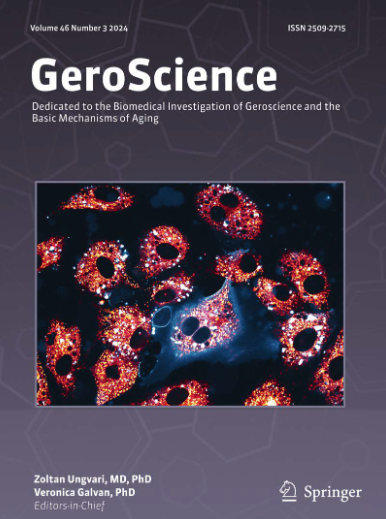环状rna作为哺乳动物卵巢老化的调节因子和生物标志物。
IF 5.3
2区 医学
Q1 GERIATRICS & GERONTOLOGY
引用次数: 0
摘要
衰老是所有细胞、组织和器官的普遍特征;某些器官,如卵巢,在哺乳动物生命的早期就经历了明显的衰老。尽管人们普遍认为卵巢中存在激素调节,但影响卵巢衰老的许多机制仍不清楚。最近,一个长期被忽视的剪接结果,小RNA分子,其特点是其圆形结构,已经得到了关注。环状rna (circRNAs)已被确定为基因转录的产物,并与其他非编码分子分类。研究人员之所以关注环状rna,是因为它们具有显著的影响蛋白质、其他rna和基因功能的能力。随着进一步发现的出现,这些分子显然对特定组织具有高度特异性,其中一些对重要的生理过程是独特的。由于目前的研究已经揭示了与基因和衰老途径之间的几个关键联系,对它们潜力的识别丰富了研究人员对卵巢发育和衰老的理解。这篇综述文章阐明了circRNA在卵巢发育能力和衰老方面的重要意义,并提出了其作为哺乳动物卵巢衰老生物标志物的潜力。本文章由计算机程序翻译,如有差异,请以英文原文为准。
Circular RNAs as regulators and biomarkers of mammalian ovarian ageing.
Ageing is a prevalent characteristic of all cells, tissues, and organs; certain ones, such as the ovaries, undergo significant ageing and do so early in the lifespan of mammals. Despite the widely recognized hormonal regulation occurring in the ovaries, numerous mechanisms influencing ovarian ageing remain unclear. Recently, a long-overlooked consequence of splicing, small RNA molecules, characterized by their circular structure, have gained attention. Circular RNAs (circRNAs) have been identified as products of gene transcription and are categorized among other non-coding molecules. The focus of researchers on circRNAs has been prompted by their remarkable capacity to influence the function of proteins, other RNAs, and genes. As further discoveries emerged, it became evident that these molecules were highly specific to particular tissues, with some being unique to significant physiological processes. The identification of their potential has enriched researchers' understanding regarding ovarian development and ageing, as several crucial connections to genes and ageing pathways have been revealed in current studies. This review article elucidates the significance of circRNA concerning the developmental competency and ageing of the ovary and suggests its potential as a biomarker for mammalian ovarian ageing.
求助全文
通过发布文献求助,成功后即可免费获取论文全文。
去求助
来源期刊

GeroScience
Medicine-Complementary and Alternative Medicine
CiteScore
10.50
自引率
5.40%
发文量
182
期刊介绍:
GeroScience is a bi-monthly, international, peer-reviewed journal that publishes articles related to research in the biology of aging and research on biomedical applications that impact aging. The scope of articles to be considered include evolutionary biology, biophysics, genetics, genomics, proteomics, molecular biology, cell biology, biochemistry, endocrinology, immunology, physiology, pharmacology, neuroscience, and psychology.
 求助内容:
求助内容: 应助结果提醒方式:
应助结果提醒方式:


